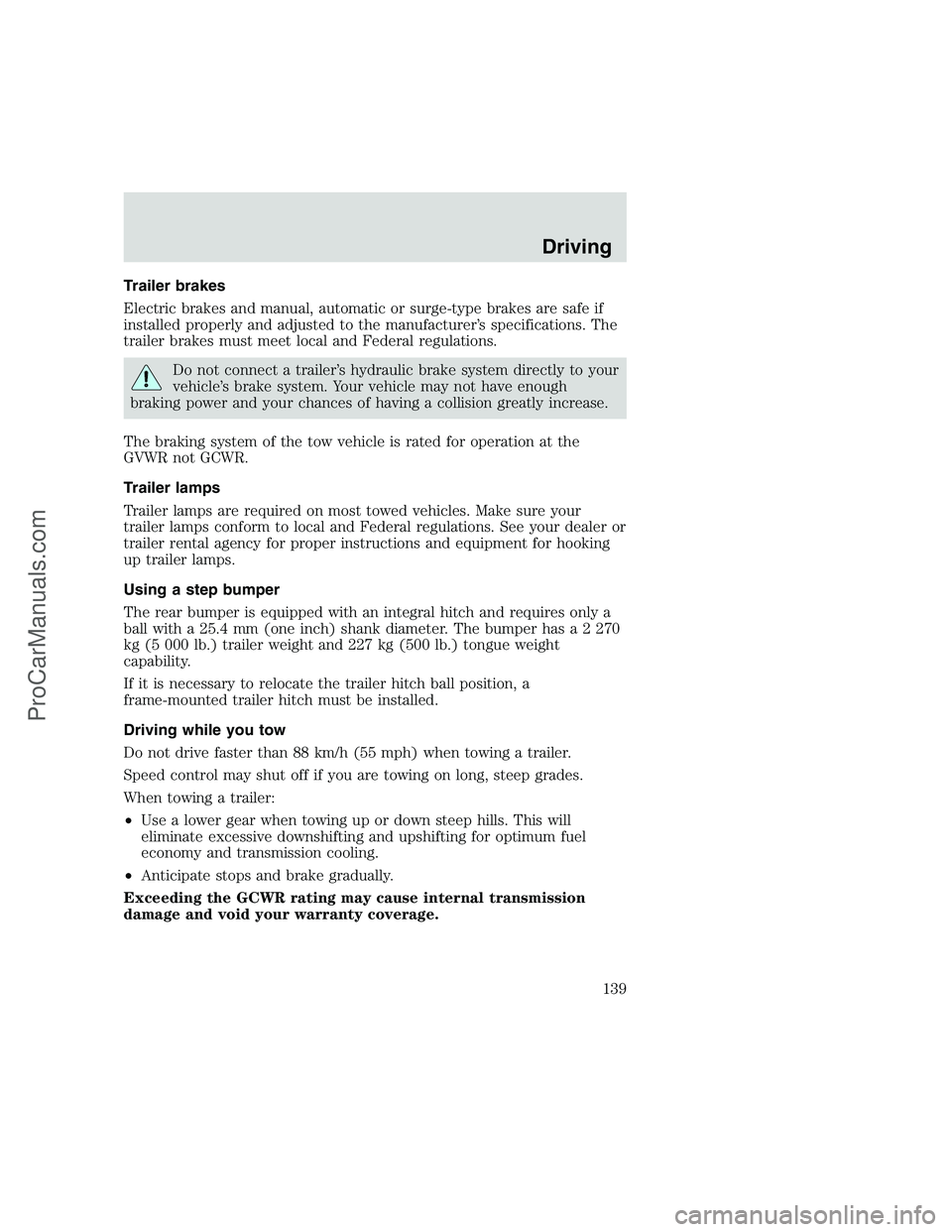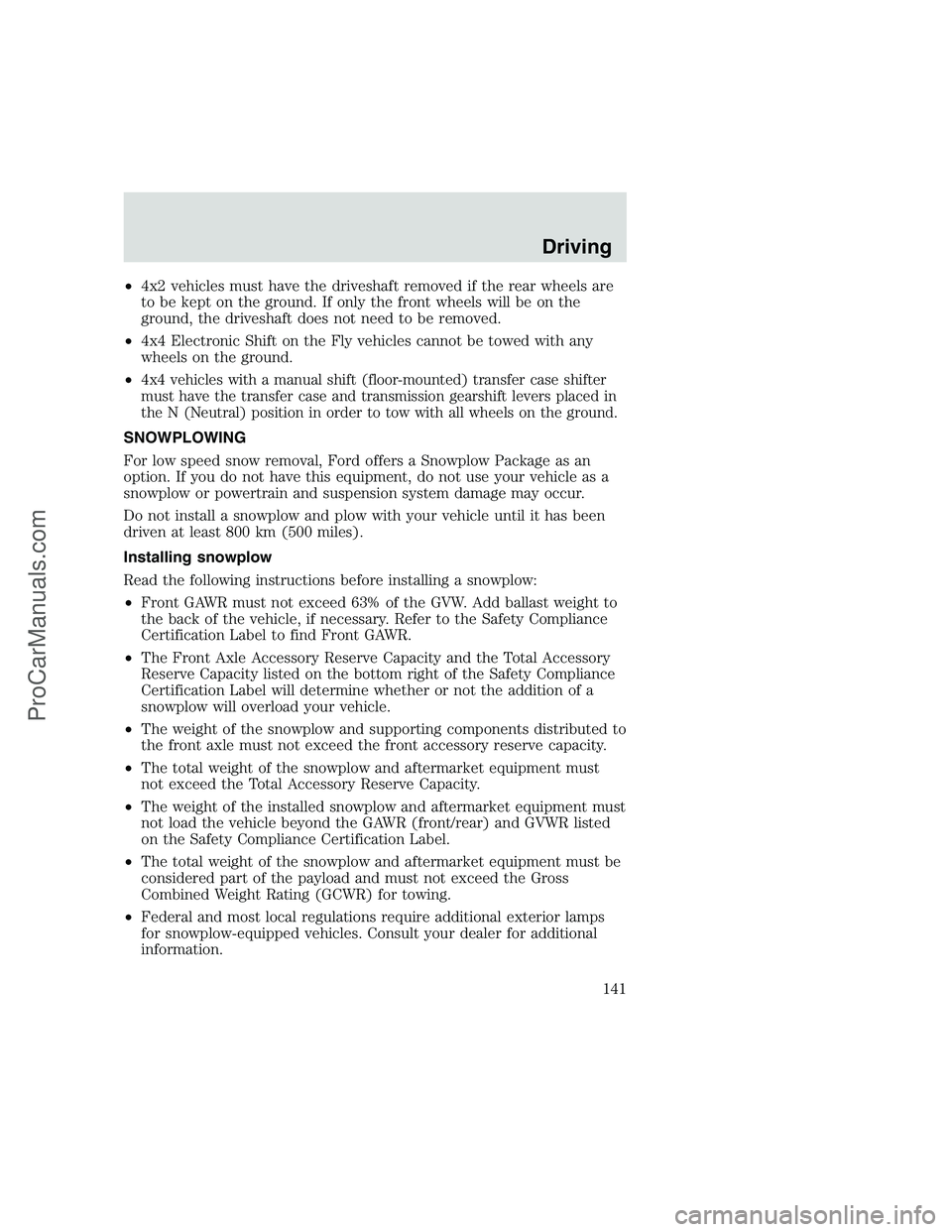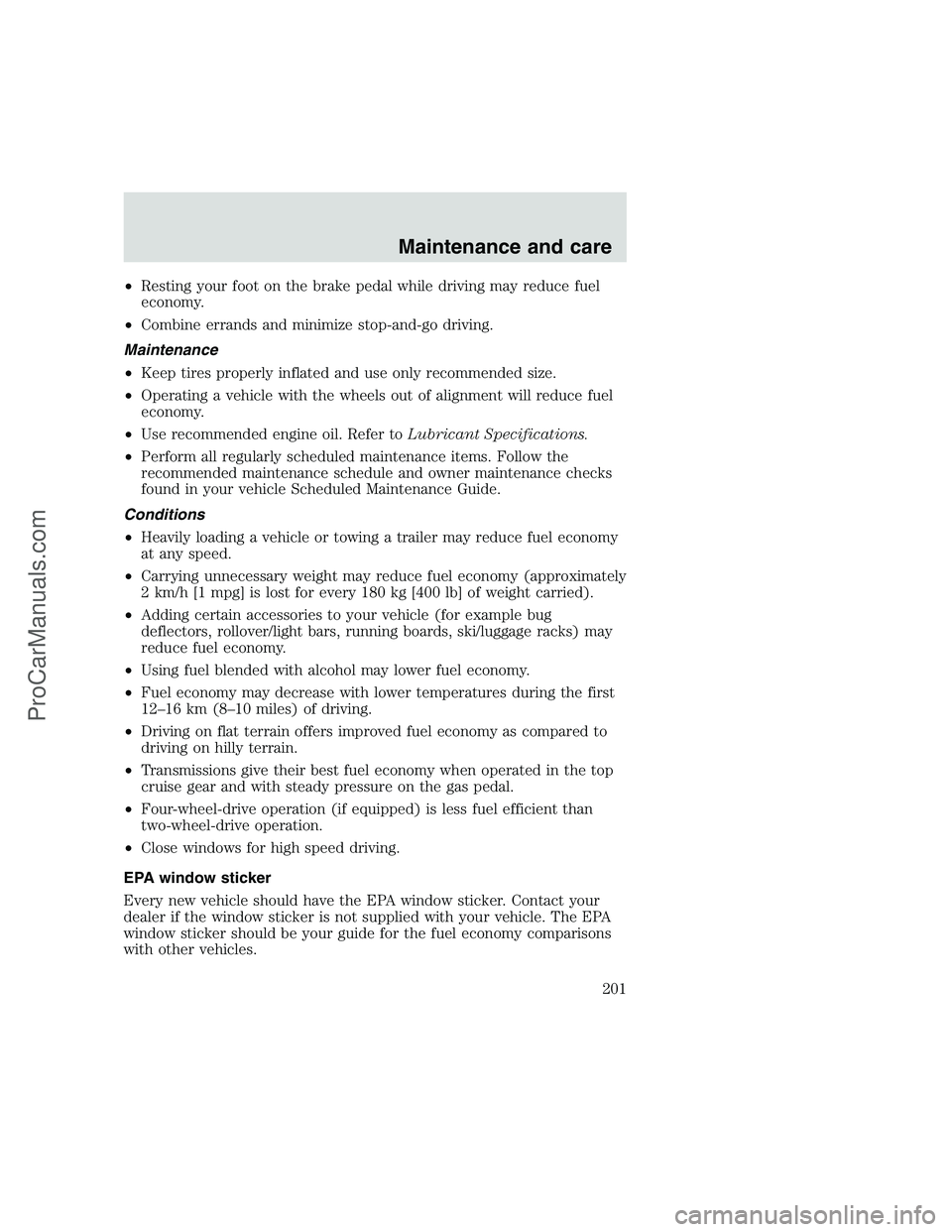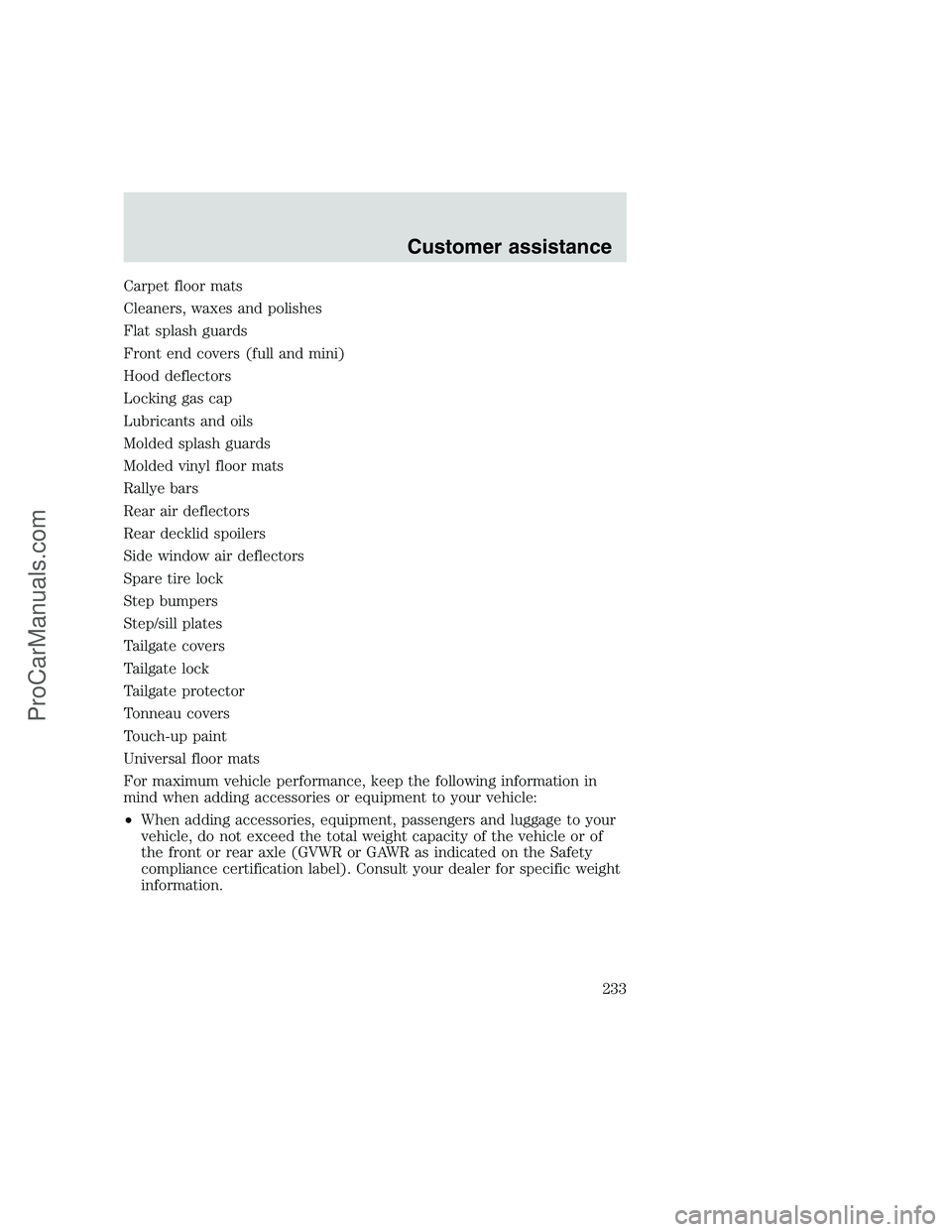1999 FORD F250 weight
[x] Cancel search: weightPage 139 of 248

Trailer brakes
Electric brakes and manual, automatic or surge-type brakes are safe if
installed properly and adjusted to the manufacturer’s specifications. The
trailer brakes must meet local and Federal regulations.
Do not connect a trailer’s hydraulic brake system directly to your
vehicle’s brake system. Your vehicle may not have enough
braking power and your chances of having a collision greatly increase.
The braking system of the tow vehicle is rated for operation at the
GVWR not GCWR.
Trailer lamps
Trailer lamps are required on most towed vehicles. Make sure your
trailer lamps conform to local and Federal regulations. See your dealer or
trailer rental agency for proper instructions and equipment for hooking
up trailer lamps.
Using a step bumper
The rear bumper is equipped with an integral hitch and requires only a
ball with a 25.4 mm (one inch) shank diameter. The bumper hasa2270
kg (5 000 lb.) trailer weight and 227 kg (500 lb.) tongue weight
capability.
If it is necessary to relocate the trailer hitch ball position, a
frame-mounted trailer hitch must be installed.
Driving while you tow
Do not drive faster than 88 km/h (55 mph) when towing a trailer.
Speed control may shut off if you are towing on long, steep grades.
When towing a trailer:
•Use a lower gear when towing up or down steep hills. This will
eliminate excessive downshifting and upshifting for optimum fuel
economy and transmission cooling.
•Anticipate stops and brake gradually.
Exceeding the GCWR rating may cause internal transmission
damage and void your warranty coverage.
Driving
139
ProCarManuals.com
Page 140 of 248

Servicing after towing
If you tow a trailer for long distances, your vehicle will require more
frequent service intervals. Refer to your Scheduled Maintenance guide
for more information.
Trailer towing tips
•Practice turning, stopping and backing up in an area before starting on
a trip to get the feel of the vehicle trailer combination. When turning,
make wider turns so the trailer wheels will clear curbs and other
obstacles.
•Allow more distance for stopping with a trailer attached.
•The trailer tongue weight should be 10–15% of the loaded trailer
weight.
•After you have traveled 80 km (50 miles), thoroughly check your
hitch, electrical connections and trailer wheel lug nuts.
•When stopped in traffic for long periods of time in hot weather, place
the gearshift in P (Park) (automatic transmissions) or N (Neutral)
(manual transmissions). This aids engine cooling and air conditioner
efficiency.
•Vehicles with trailers should not be parked on a grade. If you must
park on a grade, place wheel chocks under the trailer’s wheels.
Launching or retrieving a boat
When backing down a ramp during boat launching or retrieval,
•Do not allow the static water level to rise above the bottom edge of
the rear bumper and
•Do not allow waves to break higher than 15 cm (six inches) above the
bottom edge of the rear bumper.
Exceeding these limits may allow water to enter critical vehicle
components, adversely affecting driveability, emissions and reliability.
Replace front and rear axle lubricants anytime the axles have been
submerged in water. Axle lubricant quantities are not to be checked
unless a leak is suspected.
Recreational towing
If you may want to tow your vehicle behind another vehicle, such as an
RV, follow these guidelines:
Driving
140
ProCarManuals.com
Page 141 of 248

•4x2 vehicles must have the driveshaft removed if the rear wheels are
to be kept on the ground. If only the front wheels will be on the
ground, the driveshaft does not need to be removed.
•4x4 Electronic Shift on the Fly vehicles cannot be towed with any
wheels on the ground.
•
4x4 vehicles with a manual shift (floor-mounted) transfer case shifter
must have the transfer case and transmission gearshift levers placed in
the N (Neutral) position in order to tow with all wheels on the ground.
SNOWPLOWING
For low speed snow removal, Ford offers a Snowplow Package as an
option. If you do not have this equipment, do not use your vehicle as a
snowplow or powertrain and suspension system damage may occur.
Do not install a snowplow and plow with your vehicle until it has been
driven at least 800 km (500 miles).
Installing snowplow
Read the following instructions before installing a snowplow:
•Front GAWR must not exceed 63% of the GVW. Add ballast weight to
the back of the vehicle, if necessary. Refer to the Safety Compliance
Certification Label to find Front GAWR.
•The Front Axle Accessory Reserve Capacity and the Total Accessory
Reserve Capacity listed on the bottom right of the Safety Compliance
Certification Label will determine whether or not the addition of a
snowplow will overload your vehicle.
•The weight of the snowplow and supporting components distributed to
the front axle must not exceed the front accessory reserve capacity.
•The total weight of the snowplow and aftermarket equipment must
not exceed the Total Accessory Reserve Capacity.
•The weight of the installed snowplow and aftermarket equipment must
not load the vehicle beyond the GAWR (front/rear) and GVWR listed
on the Safety Compliance Certification Label.
•The total weight of the snowplow and aftermarket equipment must be
considered part of the payload and must not exceed the Gross
Combined Weight Rating (GCWR) for towing.
•Federal and most local regulations require additional exterior lamps
for snowplow-equipped vehicles. Consult your dealer for additional
information.
Driving
141
ProCarManuals.com
Page 201 of 248

•Resting your foot on the brake pedal while driving may reduce fuel
economy.
•Combine errands and minimize stop-and-go driving.
Maintenance
•Keep tires properly inflated and use only recommended size.
•Operating a vehicle with the wheels out of alignment will reduce fuel
economy.
•Use recommended engine oil. Refer toLubricant Specifications.
•Perform all regularly scheduled maintenance items. Follow the
recommended maintenance schedule and owner maintenance checks
found in your vehicle Scheduled Maintenance Guide.
Conditions
•Heavily loading a vehicle or towing a trailer may reduce fuel economy
at any speed.
•Carrying unnecessary weight may reduce fuel economy (approximately
2 km/h [1 mpg] is lost for every 180 kg [400 lb] of weight carried).
•Adding certain accessories to your vehicle (for example bug
deflectors, rollover/light bars, running boards, ski/luggage racks) may
reduce fuel economy.
•Using fuel blended with alcohol may lower fuel economy.
•Fuel economy may decrease with lower temperatures during the first
12–16 km (8–10 miles) of driving.
•Driving on flat terrain offers improved fuel economy as compared to
driving on hilly terrain.
•Transmissions give their best fuel economy when operated in the top
cruise gear and with steady pressure on the gas pedal.
•Four-wheel-drive operation (if equipped) is less fuel efficient than
two-wheel-drive operation.
•Close windows for high speed driving.
EPA window sticker
Every new vehicle should have the EPA window sticker. Contact your
dealer if the window sticker is not supplied with your vehicle. The EPA
window sticker should be your guide for the fuel economy comparisons
with other vehicles.
Maintenance and care
201
ProCarManuals.com
Page 233 of 248

Carpet floor mats
Cleaners, waxes and polishes
Flat splash guards
Front end covers (full and mini)
Hood deflectors
Locking gas cap
Lubricants and oils
Molded splash guards
Molded vinyl floor mats
Rallye bars
Rear air deflectors
Rear decklid spoilers
Side window air deflectors
Spare tire lock
Step bumpers
Step/sill plates
Tailgate covers
Tailgate lock
Tailgate protector
Tonneau covers
Touch-up paint
Universal floor mats
For maximum vehicle performance, keep the following information in
mind when adding accessories or equipment to your vehicle:
•When adding accessories, equipment, passengers and luggage to your
vehicle, do not exceed the total weight capacity of the vehicle or of
the front or rear axle (GVWR or GAWR as indicated on the Safety
compliance certification label). Consult your dealer for specific weight
information.
Customer assistance
233
ProCarManuals.com
Page 238 of 248

GAWR
(Gross Axle Weight Rating) .....132
calculating ...............................134
definition .................................132
driving with a heavy load ......132
location ....................................132
GVWR (Gross Vehicle
Weight Rating) ..........................132
calculating ........................132,134
definition .................................132
driving with a heavy load ......132
location ....................................132
Hazard flashers .........................144
Headlamps ...................................22
aiming ......................................208
daytime running lights .............22
flash to pass .........................23,73
high beam .......................12,22,72
turning on and off ....................22
warning chime ..........................13
Heating ........................................24
heater only system ...................24
heating and air
conditioning system .................26
Hood ..........................................171
Ignition .......................................217
positions of the ignition ...........66
removing the key ....................124
Infant seats (see Safety seats)...102
Inspection/maintenance
(I/M) testing ..............................203
Instrument panel
cleaning ...................................210
lighting up panel and interior....23
location of components ..............8
Jump-starting your vehicle ......163
Keys
key in ignition chime ...............13
positions of the ignition ...........66
Lamps
autolamp system .....................203
cargo lamps ...............................23daytime running light ...............22
headlamps .................................22
headlamps, flash to pass .....23,73
instrument panel, dimming .....23
replacing
bulbs ............203,204,205,206,207
Lane change indicator
(see Turn signal) ........................66
Lights, warning and indicator ......8
air bag ........................................10
anti-lock brakes (ABS) .....11,113
brake ..........................................11
charging system ........................12
check coolant ............................13
door ajar ....................................13
engine oil pressure ...................13
high beam .................................12
low fuel ........................................8
safety belt .................................11
service engine soon .................8,9
turn signal indicator .................12
Load limits .................................132
GAWR ......................................132
GVWR ......................................132
trailer towing ..........................132
Lubricant specifications ....215,217
Lumbar support, seats ...............84
Manual transmission .................119
fluid capacities ........................212
lubricant specifications ..........217
Message center ...........................17
english/metric button ...............17
menu button .............................18
Mirrors
fold away ...................................76
side view mirrors (power) .......75
Motorcraft parts .................198,212
Octane rating ............................196
Odometer .....................................15
Overdrive .....................................73
Panic alarm feature,
remote entry system ..................78
Index
238
ProCarManuals.com